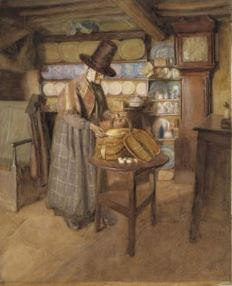
Abaddon
 26. 04. 2024
26. 04. 2024



 08. 06. 2020
08. 06. 2020

Painting can sometimes look like an ordinary work, but on closer inspection we find the painter's legacy - carefully smuggled into his work. Many painters throughout history have smuggled carefully hidden "Easter eggs" into their works - seemingly random details that are supposed to convey a meaning.
For example, Jan van Eyck painted a mirror behind Arnolfini's couple in his painting Arnolfini's portrait; when you look at this mirror with a magnifying glass, you can see the author himself greet his husband in the doorway. Hans Holbein Jr.'s painting, called Envoys, also contains an unusual elongated object on the floor. If the viewer looks at the image from a certain angle, the spot turns into an ominous skull, which is often interpreted as a reminder of human fragility.
In 1908 he painted an English painter Sydney Curnow Vosper image called Salemdepicting the interior of the Baptist Chapel of Capel Salem in North Wales. In the middle is a traditionally dressed old woman and in the background several praying figures. Vosper created a series of paintings depicting piety and religious devotion across the British Isles, and although he was English, Salem became an icon of Wales. Today, the framed print of the painting can be seen in many Welsh museums and government institutions, while the original can be seen in the Lady Lever Art Gallery in Port Sunlight, England.
Ever since the artist first introduced Salem, the painting has been the subject of debate among art critics and historians. Although the painting officially represents a pious and deeply religious scene, some of its details seem somewhat mysterious and are believed to indicate a deeper and darker symbolic meaning: a representation of vanity. The central figure, modeled on an older Welsh woman named Siân Owen, is covered in an intricately decorated scarf in rich colors. Some scientists claim that the folds of the devil's face are hidden in the folds of the scarf around the old woman's arm. If one looks closely, it seems that the contours of the mouth, eyes and beard can really be recognized on the wrinkled parts of the clothing.
Another detail that critics say supports the theory is the clock on the chapel wall, which shows 10 minutes to 10. This detail is important because it may come across the fact that an old woman arrived at church 10 minutes later in the middle of the painting, during the traditional silence, which marks the beginning of the Welsh morning service. While all the other figures in the painting are seated and look motionless, the old woman in the middle walks to her seat. So if this theory that the image represents vanity is true, an old woman deliberately comes to church at a time of silent prayer for pious churchmen to see her expensive and elaborate clothes, and the devil's face in the folds of a shawl represents her sinful vanity.
From the origin of the painting in 1908 until Vosper's death in 1942, the artist was asked by several interviewers whether encrypted details were intentionally incorporated into the painting. However, he denied this and stated that he intended to depict the purely pious and religious atmosphere of the original Welsh morning service. According to Siân Owen, he also painted his next painting, called Market Day in Old Wales, in which an old woman is dressed in a much more common traditional dress.

Market Day in Old Wales (1910), later a painting by Vosper, also according to Siân Owen
Nevertheless, Vosper was an enigmatic painter who enjoyed incorporating hidden details into his paintings. He revealed that one particular detail was deliberately hidden in the Salem painting: the chapel window in the background contains a haunted face. Although Vosper admitted that the mysterious face had been intentionally added to the painting, he declined to comment on its meaning. Since this proves that Salem contains a hidden symbolic layer, it is necessary to ask whether the devil in the details of the shawl is really an ominous representation of sinful vanity or just a special example of pareidolia. In any case, Vosper's Salem is an artistic heritage that impresses with its beauty and carefully selected details.
It is visited by millions of people every year Museum Worldwide. They admire famous sculptures, paintings, archaeological exhibits. But do they know that many of these alleged historical findings are in fact successful hoaxes? The author of world bestsellers will guide you Falsified archeology.